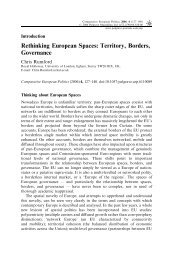Europeanisation, National Identities and Migration ... - europeanization
Europeanisation, National Identities and Migration ... - europeanization
Europeanisation, National Identities and Migration ... - europeanization
You also want an ePaper? Increase the reach of your titles
YUMPU automatically turns print PDFs into web optimized ePapers that Google loves.
German trade unions <strong>and</strong> Polish migrant workers 211<br />
With regard to this universal attitude, the organisational ‘because motive’ is thus not<br />
a xenophobic or an exclusionist, but a protectionist one. The claim for exclusionist<br />
practices <strong>and</strong> the use of xenophobic images among its own members is a more<br />
derived ‘in-order-to motive’.<br />
The political opportunity structure, however, restricted <strong>and</strong> prevented for<br />
particular constellations the realisation of strict exclusionist strategies. In the case<br />
of the East European contract workers, the German government could not cancel<br />
the intergovernmental agreements for diplomatic <strong>and</strong> foreign policy reasons. In<br />
this situation, IG BAU dem<strong>and</strong>ed alternatively the reduction of limits set by the<br />
intergovernmental agreements <strong>and</strong> the tightening of controls. In the case of the free<br />
movement of workers from accession states, IG BAU dem<strong>and</strong>ed as an alternative<br />
to the impossible exclusionist measure, the postponement of free entry. IG BAU<br />
turned to inclusive measures only in constellations which lacked exclusionist options.<br />
In the case of GDR workers, the organisation exp<strong>and</strong>ed to the accession area <strong>and</strong><br />
integrated the construction workers from East Germany. In the case of posted EU<br />
workers, IG BAU dem<strong>and</strong>ed from the beginning the integration of temporarily<br />
employed workers in the German system of social protection.<br />
Continuation of traditional stereotypical<br />
argumentation<br />
The above account has revealed that the undoubtedly existing difficulties within the<br />
German construction labour market are framed by IG BAU persuasion efforts as<br />
problems caused by outside interlopers. The categories of interlopers examined are<br />
differently evaluated: the influx from other EU member states is reluctantly accepted<br />
(in the law-abiding form). But interlopers from East Europe – with a particular<br />
stress on workers from Pol<strong>and</strong> – were principally rejected. In the German discourse<br />
on the employment of East European contract workers as well as on the Eastern<br />
enlargement <strong>and</strong> the illegal employment, an outst<strong>and</strong>ing role is ascribed to<br />
the Polish nationality: a good indicator for this constellation was the use of the term<br />
‘Polish prices’ covering the cheaper bargain tender offered by foreign enterprises<br />
(Faist et al. 1999). Two reasons probably may have caused the prominent perception<br />
of the Polish nationality: Pol<strong>and</strong> was <strong>and</strong> is the most important of the East European<br />
sending countries <strong>and</strong> holds in all categories the greatest share of temporary migrant<br />
labour in Germany (Cyrus 1994 <strong>and</strong> 2001b; Hönekopp et al. 2001). To explain<br />
particular attention to Pol<strong>and</strong>, it is insufficient to refer to empirical facts. The<br />
perception <strong>and</strong> interpretation of facts or situations is guided by the cultural<br />
embedding. The meaning which social actors attach to social reality <strong>and</strong> situations<br />
depends on the social <strong>and</strong> cultural context. In the case of labour migration from<br />
Pol<strong>and</strong>, the cultural embedding is framed by a far-reaching historical experience<br />
of Polish labour migration to Germany (Bade 2001). In Pol<strong>and</strong> the contemporary<br />
use of old fashioned terms like ‘going to Saxony’ or ‘going to the Reich’ signal that<br />
the perception of the contemporary labour migration is still framed by the historical<br />
experiences (Morawska 1998; Korczynska 2001). On the other side, in Germany<br />
the image of Polish labour immigration is deeply rooted as well in the national



